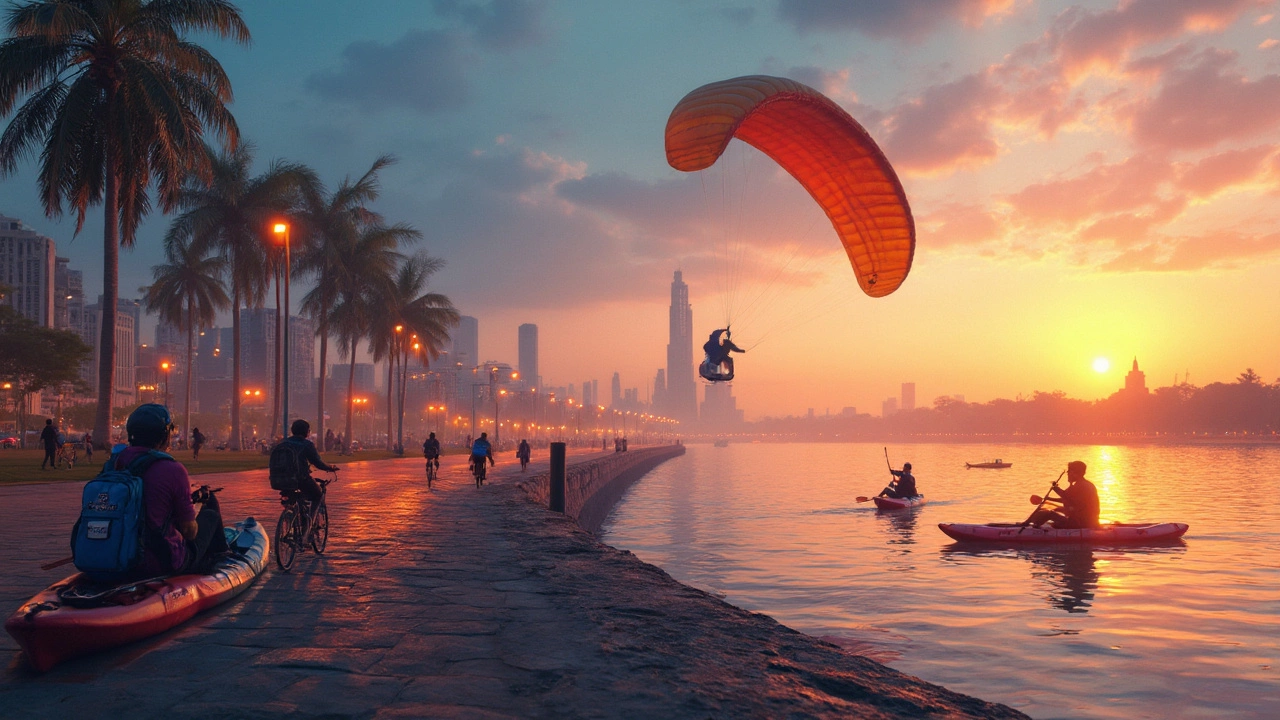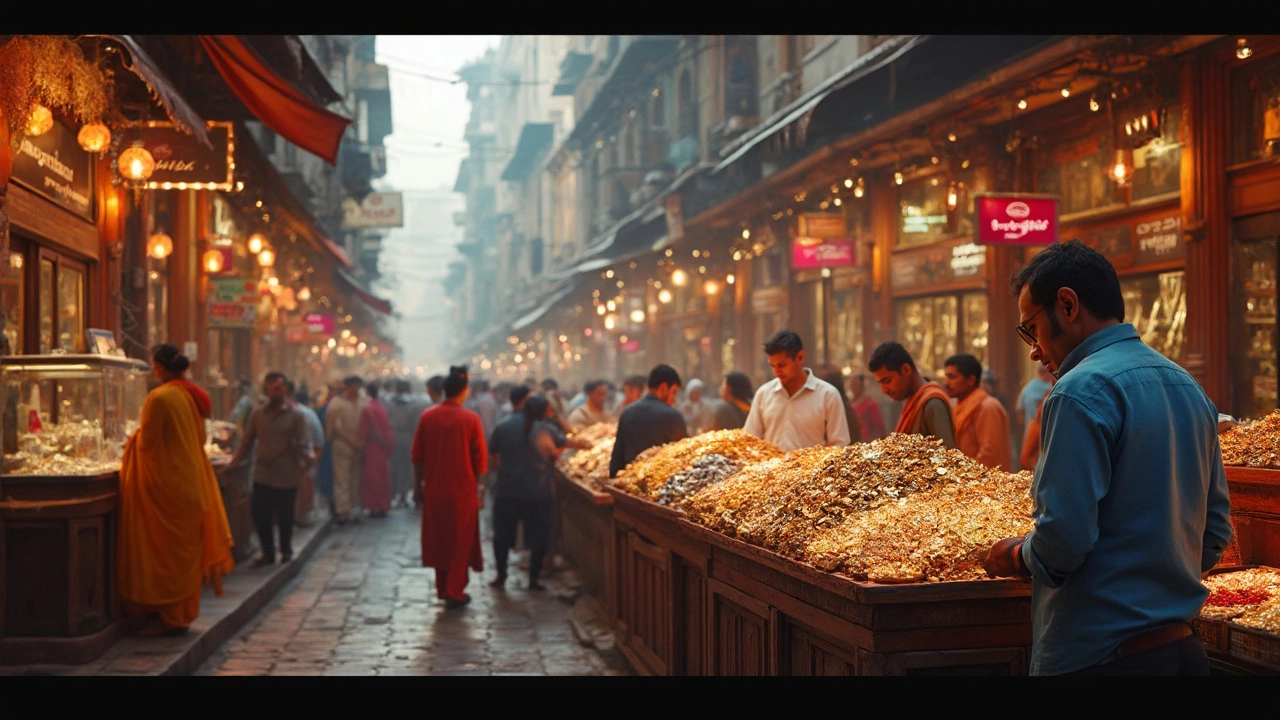Surat doesn’t just top the charts for its diamond trade—this buzzing city in Gujarat is earning some serious cred as an adventure sports magnet. Before you get lost in fancy brochures, let’s get clear: when Indians talk about the 'Diamond City,' they mean Surat. No other city in India comes close in terms of polished diamond exports; around 90% of the world’s diamonds go through Surat’s workshops. That’s not an exaggeration. So, the nickname isn’t just marketing. It’s real, lived proof of the city’s global status.
But this place isn’t only about gems. It’s fast turning into a playground for thrill-seekers, too. Ever tried paramotoring along the Tapti riverfront or kayaking just a quick drive from the diamond markets? Surat is making a mark—and if you’re the type who likes earning bragging rights, you’ll want to know where and when the action heats up. Not sure what to pack or which local clubs hook you up with gear? Stick around. The best bits aren’t on the tourist posters.
- Why Surat is Called Diamond City
- Adventure Sports Scene in Surat
- Hidden Spots and Practical Tips
- Planning Your Visit: What to Know
Why Surat is Called Diamond City
Surat and diamonds go hand in hand. The city has earned its nickname because it’s the world’s biggest diamond cutting and polishing hub. Over 90% of the world’s diamonds, yes, the ones you see in shiny engagement rings and necklaces everywhere, are processed right here. That’s not just an Indian fact—this is global. The diamond trade gives work to more than half a million people in Surat, from tiny family operations to large cutting factories that feel like mini cities.
What’s wild is that Surat isn’t a place where diamonds grow or get mined. Most rough diamonds arrive in bulk shipments from Africa, Russia, and even Canada. Local artisans with insane skill take these raw stones and turn them into sparkling gems. It’s a craft that’s been passed down through generations. The difference between a rough stone and a polished diamond is huge, and Surat’s folks know all the tricks to make them shine.
The city’s diamond industry kicked off in the 1960s, grew fast, and never looked back. Modern tech keeps pushing the game forward—factories now use lasers and computers to get the most out of each stone. There’s even a massive area called the Surat Diamond Bourse, which is the world’s largest office building, dedicated just to the diamond business.
With so many livelihoods depending on diamonds, and with Surat being the main player in this trade, it’s no surprise the city picked up the name Diamond city. Ask any local, and they’ll proudly back it up with real stories about families who’ve been in the game since day one.
Adventure Sports Scene in Surat
Ask locals about Surat, and sure, they’ll talk diamonds. But if you hang around the right circles, you’ll hear them brag about their adventure sports. In the past five years, Surat’s outdoor scene has exploded. New clubs and organizers are popping up everywhere, catering to weekend warriors who want more than street food and shopping.
The city's riverfront development project has really opened up action on the Tapti River. You’ve got kayaking and canoeing—a legit surprise for a place mostly known for its industry. Local outfit River Riders Surat says their group rides have nearly tripled since 2022. For those who’d rather get their heart racing above ground, there’s rock climbing at the Pandesara Climbing Wall and bouldering at smaller gyms in town. They aren’t world-famous gyms, but the buzz is real and the people welcoming.
“We never expected this much interest in paddleboarding or mountain biking within city limits, but it’s all happening,” says Kunal Trivedi of Surat Adventure Club. “The younger crowd wants something different than cricket.”
If you’re up for speed, head out to Dumas Beach for jet skiing and weekend sand biking. There’s kite surfing on windy days, too. For a panoramic view of the river and city, try paramotoring with local guides—just check that you’re picking a group certified by the Gujarat Adventure Sports Association.
| Activity | Best Spot | Approx. Cost (per session, INR) | Best Months |
|---|---|---|---|
| Kayaking | Tapti Riverfront | 500-700 | October-March |
| Jet Skiing | Dumas Beach | 800-1200 | November-April |
| Paramotoring | Tapti Riverside | 2500-3000 | October-February |
| Rock Climbing | Pandesara Wall | 300-500 | Year-round |
| Kite Surfing | Dumas Beach | 1000-1500 | December-March |
If you thought Surat was just the Diamond city, you’ll be shocked by how much action is really out there. Most local clubs handle equipment rentals and beginner lessons, so you don’t need experience or gear to join. Just show up, sign the waiver, and get moving. Safety matters a lot here—look for trained instructors and well-maintained equipment. Trust the vibe, but always double-check credentials before you jump in. Surat might not be India’s adventure capital (yet), but it’s closing the gap fast.

Hidden Spots and Practical Tips
If you want more than the usual Surat city highlights, there are some local adventure gems worth checking out. You won’t see these places plastered all over Instagram, but they’re favorites among people who actually live here. Start with the Dumas Beach strip—not the crowded main patch, but the quieter ends near Dumas village. Local groups offer sunrise cycling tours here, which are a game-changer compared to the sweaty midday hustle.
For those chasing water sports, the two main spots are Gopi Talav for paddle boating and kayaking, and the Tapti River’s western stretch—especially after the monsoon when river safaris ramp up. The best part? Rentals are cheap, with kayaking gear running as low as ₹300 an hour. Gopi Talav is open till 9 PM, so you’ve got options even after dark.
Want something offbeat? Locals tip the Urban Forest Trail in Adajan for hiking and trail biking. It’s a bit wild but safe in groups. The trail’s open sunrise to sunset, and you’ll usually dodge the crowds if you hit it midweek. For BMX or skateboarding, try the Veer Narmad Skate Park. It’s a small scene, but the regulars are super friendly and don’t mind showing newbies some tricks.
Safety and gear rental tips matter here. Stick to trusted vendors at popular sites—ask for helmets and proper life jackets. Believe it or not, Surat’s main adventure groups (like Surat Adventurers and Tapti River Sports Club) are active on WhatsApp, not just big social apps. DM them for real-time updates, especially about pop-up events or night kayaking—these don’t usually make it onto tourist listings.
Need to compare costs and timings? Here’s a handy cheat sheet:
| Activity | Best Spot | Approx. Cost (₹) | Best Time |
|---|---|---|---|
| Kayaking | Gopi Talav | 300/hour | Oct–Mar, evenings |
| Cycling Tour | Dumas Beach (quiet end) | Upwards of 250 | Early morning |
| Trail Hiking | Urban Forest Trail | Free | Sunrise/Midweek |
| River Safari | Tapti River, west side | 900 per ride | Post-monsoon |
One last thing. The Diamond city has unpredictable weather from late June to September—heavy rains can shut down outdoor activities. Always check the forecast and call ahead for slot confirmations so you don’t waste a trip. Cash is still king at many rental spots and mobile data isn’t the best on beach stretches, so download your maps and payment apps before you set out.
Planning Your Visit: What to Know
If you’re flying into Surat, the airport’s barely 12 km from the city center and connects to major Indian hubs like Mumbai and Delhi. If you’re coming by train, Surat Railway Station sits right on National Highway 8, making it dead simple to grab a cab or rickshaw and be at your hotel in minutes. Surat’s weather is hot from March to June, so the best time for adventure sports is October to February, when mornings are breezy and way more comfortable.
Packing for adventure outings here? Go for light activewear, quick-dry clothes, sneakers, and sunscreen. If you’re planning to hit Surat’s rivers or lakes, include a rash guard, hat, and mosquito repellent. Some of the local adventure clubs will rent out safety gear—just double-check the quality and ask if equipment sanitization is included.
Want a quick bite before heading out? Surat is big on street snacks. Try locho from roadside stalls or a hot plate of undhiyu. Food’s cheap here. Local travel apps like Surat Vikas or Google Maps are super helpful for finding meeting points or tracking public buses, which show up on time surprisingly often.
Here’s a quick look at average costs you can expect while exploring Surat for adventure sports:
| Activity | Avg. Cost (INR) | When Available |
|---|---|---|
| Paramotoring (15 min) | 3000 | Oct-Mar |
| Kayaking (1 hour) | 900 | Nov-Mar |
| ATV Biking (30 min) | 700 | Year-round |
| Ziplining (Single ride) | 500 | Oct-Mar |
If you want a local guide for your first adventure outing, ask around at your hotel. Most guesthouses know people or clubs who offer basic safety briefings in English and Hindi. And if you’re looking for the heart of the Diamond city experience, don’t skip a stroll on the riverfront at sunset—the energy there is unbeatable.
